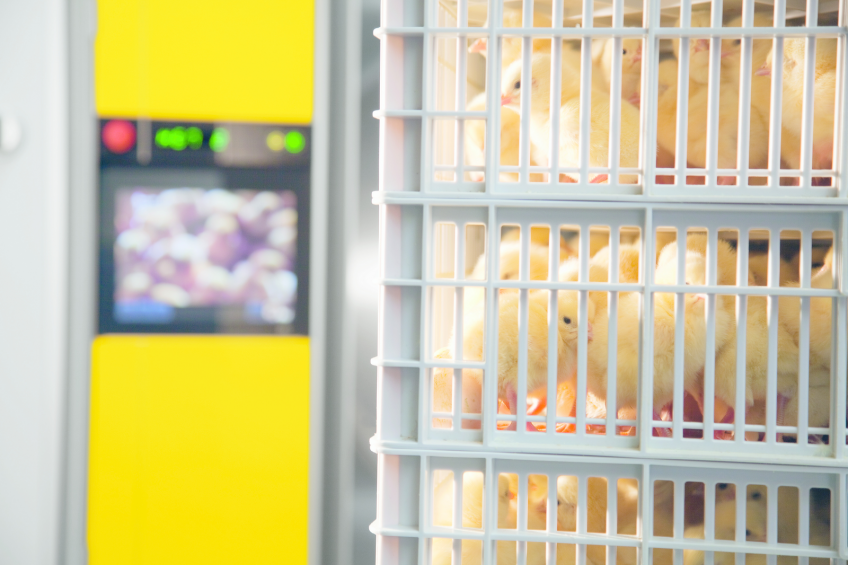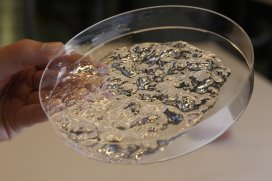Post-hatch feeding made easy, practical and flexible

A unique partnership between a hatchery expert, biotech start-up and premix company has led to a game changing post-hatch feeding product: SmartStart™.
Aiming for the shortest possible spread of hatch remains paramount in single stage incubation. A sub-optimal hatch window can lead to chicks having to wait a long time before having access to feed and water. To promote the welfare of day-old chicks in situations with prolonged hatch windows, there is growing demand for flexible solutions that offer the freedom to access feed and water immediately upon hatching. But inside the warm environment of a hatcher, open water systems are prone to contamination and to the cultivation of bacteria. An innovative new idea, developed by a consortium of three companies, has created a smart, practical concept that locks the water inside a semi-moist feed. It is a solution easily applied without modification to existing hatchers, to give the youngest chicks a perfect start.
Post-hatch feeding is gaining interest
Hatching is a fine art and Pas Reform, the Dutch supplier of integrated hatchery solutions, has fine-tuned this skill over the last ten decades. But the hatching of chicks entails more than having the right hatchery equipment, the right climate conditions and an optimised hatch window. The concept of post-hatch feeding is attracting the interest of poultry producers around the world, as animal welfare organisations in some areas demand that chicks (and farm animals in general) should have access to feed and water as soon as they are born. Common practice is to supply feed and water as soon as chicks arrive at the farm. Feeding (gels or semi-moist feed) during transport is typical for day-old parent- and grandparent breeding stock, because they often have to travel long distances. “Before the chicks are transported, access to feed and water may be required not only from a welfare perspective and because some of our customers are increasingly keen on this practice, but also for the overall development of the day-old chick. A growing body of research indicates that post-hatch feeding may actually provide a better start for day-old chicks,” explains Gerd de Lange, senior poultry specialist at Pas Reform.

Fruitful partnership
Pas Reform’s interest in delving deeper into post-hatch feeding comes from the desire to provide customers with a total hatchery solution. Hatcheries constantly strive to reduce the hatch window, which is normally between 12-24 hours. Maintaining the shortest possible spread of hatch is essential for achieving a uniform batch of day old chicks. However, less than optimum climate control in the hatchery, combined with the fact that hatching eggs are often collected from different sources (breed, flock age, storage time) and thus have different incubation times, can result in longer than ideal hatch windows. When the hatch window is prolonged, the chicks that hatch earliest have to wait a long time in the hatcher basket before being transported and finally gaining access to feed and water. “To promote improved welfare for day-old chicks in situations with prolonged hatch windows, there is evidence to suggest that it is better to give them access to feed and water immediately after hatching,” explains Bouke Hamminga, director International Sales and Business Development at Pas Reform. “Our focus is on providing our customers with total, flexible hatchery solutions across the complete product range – so of course, we are keen to develop an effective solution for customers who wish to use post-hatch feeding. “This desire has prompted us to seek out the right expertise, to initiate new partnerships with two exciting and innovative Dutch companies, the biotech start-up In Ovo and premix specialist Twilmij.”

Feed and water combined
All three companies involved in the new project agreed that the approach must be to develop a practical, flexible and easy to use solution, that enabled chicks to freely access feed and water as soon as possible in the hatcher. “Some post-hatch feeding systems are already used by the industry, but they often require large investment and intensive adaptations to the incubation systems currently in use. “We wanted to focus on developing a post-hatch feed that can be used in hatcher baskets, a system that is used often around the world,” explains Wouter Bruins, co-founder of In Ovo. Twilmij has a lot of experience with their existing feed formulation After Egg Food, which is used during the transportation of day-old chicks. Marien van den Brink, R&D Manager and Poultry Nutritionist at Twilmij explains: “After teaming up, we wanted to investigate possible new products or how we could make our After Egg Food compatible for use in a hatchery. Our feed is a semi-moist, red coloured crumble with a water content of 30% that also contains high quality ingredients and fragrances.

“But water evaporates in the warm conditions (37° Celsius) of a hatchery, especially in combination with high air flow, so our question was whether we could find a method of retaining water in the product while it was exposed to the hatcher environment. This way, a liquid water supply, which is currently offered in alternative post-hatch feeding systems, is not needed. Water in the hatchery is prone to contamination and bacterial growth. This is an extra risk for the small chicks.” Bruins: “In a quest to find solutions to supply water and feed as a combined product, we came across the work of some biochemical scientists at the Leiden University, in the city where In Ovo is also based.” Dr Choi and his team there are working on deep eutectic solvents (called NADES), which are ingredients from nature, often found in desert plants (see side box). They found that a certain combination of solid ingredients mixed together results in a liquid formulation. And more importantly, this mix remains liquid and can trap water, in such a way that it hardly evaporates. “This is really great,” explains Wouter Bruins, “as we saw a clear link between this discovery and post-hatch feeding. We saw an opportunity to find a NADES mix that could be used in animal feed – something that has never been done before – and possibly added to the After Egg Food from Twilmij in order to retain its high water content.”

SmartStart™ as a result
NADES comes in all shapes and sizes and the challenge was to find an optimal combination that is applicable in feed and safe to use. Bruins from In Ovo explains: “Our search resulted in a NADES made of a sugar mixed with small amounts of vitamins and water. It is safe to use in this application and tests have shown that water was retained for at least three days in a hatcher at the required level. Adding this NADES to the After Egg Food created a unique new product, which we have named SmartStart™. SmartStart™ can be placed in the hatcher basket upon egg transfer without worrying that the feed will dry out. In other words, a very practical and uncomplicated approach,” says De Lange from Pas Reform. At the same time, the ingredients of NADES are excellent nutrients for the chick, in addition to the ingredients of Twilmij’s After Egg Food. “The purpose of SmartStart™ is to enable post-hatch feeding to be applied with relative convenience, flexibility, limited extra labour and in existing hatchers. It is suitable for use in modular incubation environments (where a hatchery can provide feed in one, two or all hatchers) – with minimum installation and investment required to start,” adds Hamminga.

Part of holistic approach
The consortium is excited that their co-operation has led to a proof of concept. The partners see the SmartStart™ development as a true game changer, as part of an holistic approach that further optimises hatchery conditions and improves technical results for the chickens, while also complying with consumer and retailer demands regarding post-hatch feeding concepts. And this is only the beginning. “We have a proof of concept. We know the chickens eat the SmartStart™ feed and we know it works in practice in the hatchery. Now we will optimise the solution, improve the feeders and automate the process,” explains De Lange. Van den Brink and Bruins add that new research and practical experiences from the field will be used to gain more insights into the use of post-hatch feeding, as some questions can only be answered when we learn from practice. “We now use a product with at least 30% water content after three days in the hatcher, the same percentage that is currently used in After Egg feed, which has proven to be sufficient. For some hatcheries, it might be adequate that all the hatched chicks have access to this feed product, to satisfy the animal welfare aspect for retailers and consumers. For other hatcheries it may be beneficial to ensure that all the hatched chicks have consumed feed and water before leaving the hatchery. Maybe then it makes sense to leave the chicks a bit longer in the hatcher baskets, so that they all pick up a few extra grams of feed. “All these questions show that post-hatch feeding is still in its infancy. We need more data to provide satisfactory answers – and SmartStart™ is certainly a very promising place to start to answer them,” explains Bruins.

Don’t forget lighting
“At the same time, it is known that lighting influences the eating behaviour of the animals. We also looked more into this as part of the SmartStart™ concept,” explains De Lange. The lighting makes it easier for the chicks to better explore their environment and find the feed. Light intensity, colour, regime (day/night rhythm), type of lighting (LED, halogen, etc.) and frequency of the light all play a part in this context. “A chicken sees a different number of images per second than we do. While we see a continuous light at some frequencies, for chickens it may seem to flicker. This is not an issue with the LEDs we apply. We have tested various lighting variations. Two aspects are key: the lighting must be easy to implement in existing hatchers and the light must be sufficient for all hatcher baskets in the hatcher, in order to make the feed visible to the day-old chicks,” adds de Lange.
Ready to test more in the field
Pas Reform remains focused on the continued development of modular, single-stage incubators, knowing that this will allow for further reduction of the hatch-window. “But we see the relevance of extending options for our customers with a product like SmartStart™,” explains Hamminga. The first steps have been taken and the first results confirm that SmartStart™ works. “This is our 1.0 version. With such strong proof of concept, we are ready to further improve this game changing post-hatch feed solution. “One thing is crystal clear. No one wants or needs to invest heavily in equipment to achieve this goal. Customers are looking for a practical, flexible solution that can be accommodated by current incubation systems: an effective solution that can help hatcheries around the world to optimise their incubation process and deliver greater numbers of uniform, healthy chicks,” concludes Hamminga.
SmartStart™ is patent pending and developed by Pas Reform in partnership with Leiden University, In Ovo and Twilmij. It is expected to hit the market in the course of 2017.

Water locking principle comes from desert plants
How is it possible that desert plant seeds start germinating after a long period of being buried in the hot, dry sand? The answer lies in natural components, also known as Natural Deep Eutectic Solvents (NADES) that can lock water inside so that it doesn’t evaporate. It is not a lipid and not water. The NADES is formed when two or more solids are mixed in a certain ratio, and subsequently become liquid in the mixture. NADES are natural, edible and, in certain combinations, stable related to water vaporisation. This wonder of nature has been known in the biochemistry world and was studied by a research team in Leiden, the Netherlands, led by Prof. Dr. Rob Verpoorte and Dr. Young Hae Choi. The ability to have solids in a liquid state is an interesting fact and you could think of a range of applications where this can be useful. In the quest to find a way to supply water in warm conditions with high air speed (in the hatcher), NADES emerged as one of the solutions to overcome evaporation in the post-hatch feed. Thickening NADES creates a NADES gel, which has the ability to retain water even better. By adding this gel to the existing product from Twilmij, the feed became useable in the hatchery.
Author: Emmy Koeleman
Join 31,000+ subscribers
Subscribe to our newsletter to stay updated about all the need-to-know content in the poultry sector, three times a week. Beheer
Beheer

 WP Admin
WP Admin  Bewerk bericht
Bewerk bericht